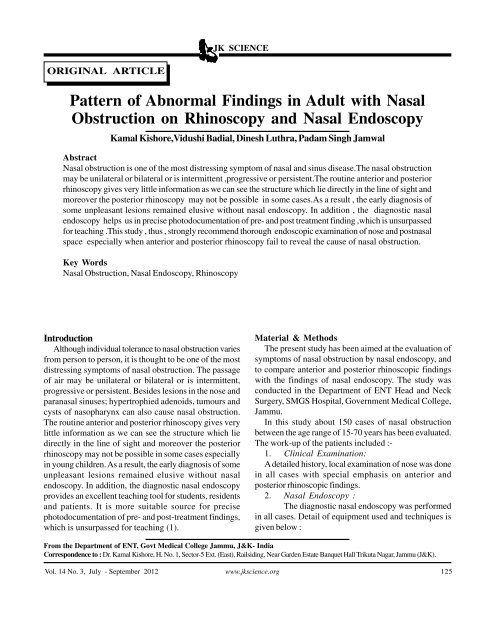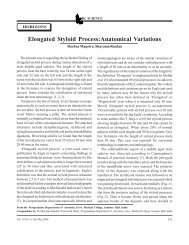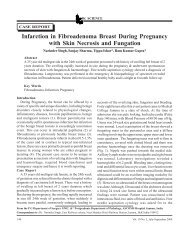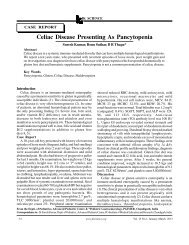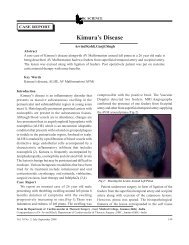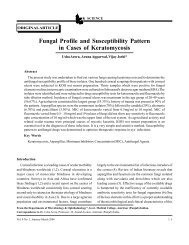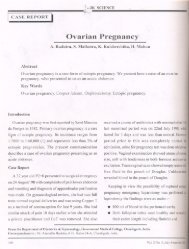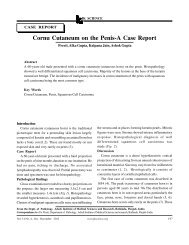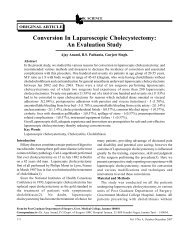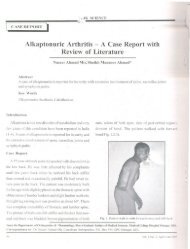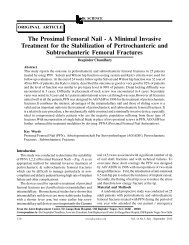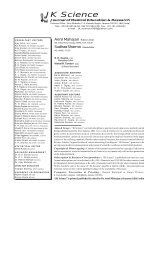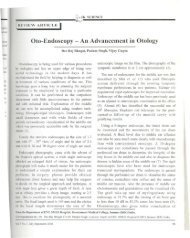125 Pattern of Abnormal Findings in Adult with Nasal ... - JK Science
125 Pattern of Abnormal Findings in Adult with Nasal ... - JK Science
125 Pattern of Abnormal Findings in Adult with Nasal ... - JK Science
You also want an ePaper? Increase the reach of your titles
YUMPU automatically turns print PDFs into web optimized ePapers that Google loves.
<strong>JK</strong> SCIENCE<br />
ORIGINAL ARTICLE<br />
<strong>Pattern</strong> <strong>of</strong> <strong>Abnormal</strong> <strong>F<strong>in</strong>d<strong>in</strong>gs</strong> <strong>in</strong> <strong>Adult</strong> <strong>with</strong> <strong>Nasal</strong><br />
Obstruction on Rh<strong>in</strong>oscopy and <strong>Nasal</strong> Endoscopy<br />
Kamal Kishore,Vidushi Badial, D<strong>in</strong>esh Luthra, Padam S<strong>in</strong>gh Jamwal<br />
Abstract<br />
<strong>Nasal</strong> obstruction is one <strong>of</strong> the most distress<strong>in</strong>g symptom <strong>of</strong> nasal and s<strong>in</strong>us disease.The nasal obstruction<br />
may be unilateral or bilateral or is <strong>in</strong>termittent ,progressive or persistent.The rout<strong>in</strong>e anterior and posterior<br />
rh<strong>in</strong>oscopy gives very little <strong>in</strong>formation as we can see the structure which lie directly <strong>in</strong> the l<strong>in</strong>e <strong>of</strong> sight and<br />
moreover the posterior rh<strong>in</strong>oscopy may not be possible <strong>in</strong> some cases.As a result , the early diagnosis <strong>of</strong><br />
some unpleasant lesions rema<strong>in</strong>ed elusive <strong>with</strong>out nasal endoscopy. In addition , the diagnostic nasal<br />
endoscopy helps us <strong>in</strong> precise photodocumentation <strong>of</strong> pre- and post treatment f<strong>in</strong>d<strong>in</strong>g ,which is unsurpassed<br />
for teach<strong>in</strong>g .This study , thus , strongly recommend thorough endoscopic exam<strong>in</strong>ation <strong>of</strong> nose and postnasal<br />
space especially when anterior and posterior rh<strong>in</strong>oscopy fail to reveal the cause <strong>of</strong> nasal obstruction.<br />
Key Words<br />
<strong>Nasal</strong> Obstruction, <strong>Nasal</strong> Endoscopy, Rh<strong>in</strong>oscopy<br />
Introduction<br />
Although <strong>in</strong>dividual tolerance to nasal obstruction varies<br />
from person to person, it is thought to be one <strong>of</strong> the most<br />
distress<strong>in</strong>g symptoms <strong>of</strong> nasal obstruction. The passage<br />
<strong>of</strong> air may be unilateral or bilateral or is <strong>in</strong>termittent,<br />
progressive or persistent. Besides lesions <strong>in</strong> the nose and<br />
paranasal s<strong>in</strong>uses; hypertrophied adenoids, tumours and<br />
cysts <strong>of</strong> nasopharynx can also cause nasal obstruction.<br />
The rout<strong>in</strong>e anterior and posterior rh<strong>in</strong>oscopy gives very<br />
little <strong>in</strong>formation as we can see the structure which lie<br />
directly <strong>in</strong> the l<strong>in</strong>e <strong>of</strong> sight and moreover the posterior<br />
rh<strong>in</strong>oscopy may not be possible <strong>in</strong> some cases especially<br />
<strong>in</strong> young children. As a result, the early diagnosis <strong>of</strong> some<br />
unpleasant lesions rema<strong>in</strong>ed elusive <strong>with</strong>out nasal<br />
endoscopy. In addition, the diagnostic nasal endoscopy<br />
provides an excellent teach<strong>in</strong>g tool for students, residents<br />
and patients. It is more suitable source for precise<br />
photodocumentation <strong>of</strong> pre- and post-treatment f<strong>in</strong>d<strong>in</strong>gs,<br />
which is unsurpassed for teach<strong>in</strong>g (1).<br />
Material & Methods<br />
The present study has been aimed at the evaluation <strong>of</strong><br />
symptoms <strong>of</strong> nasal obstruction by nasal endoscopy, and<br />
to compare anterior and posterior rh<strong>in</strong>oscopic f<strong>in</strong>d<strong>in</strong>gs<br />
<strong>with</strong> the f<strong>in</strong>d<strong>in</strong>gs <strong>of</strong> nasal endoscopy. The study was<br />
conducted <strong>in</strong> the Department <strong>of</strong> ENT Head and Neck<br />
Surgery, SMGS Hospital, Government Medical College,<br />
Jammu.<br />
In this study about 150 cases <strong>of</strong> nasal obstruction<br />
between the age range <strong>of</strong> 15-70 years has been evaluated.<br />
The work-up <strong>of</strong> the patients <strong>in</strong>cluded :-<br />
1. Cl<strong>in</strong>ical Exam<strong>in</strong>ation:<br />
A detailed history, local exam<strong>in</strong>ation <strong>of</strong> nose was done<br />
<strong>in</strong> all cases <strong>with</strong> special emphasis on anterior and<br />
posterior rh<strong>in</strong>oscopic f<strong>in</strong>d<strong>in</strong>gs.<br />
2. <strong>Nasal</strong> Endoscopy :<br />
The diagnostic nasal endoscopy was performed<br />
<strong>in</strong> all cases. Detail <strong>of</strong> equipment used and techniques is<br />
given below :<br />
From the Department <strong>of</strong> ENT, Govt Medical College Jammu, J&K- India<br />
Correspondence to : Dr. Kamal Kishore, H. No. 1, Sector-5 Ext. (East), Railsid<strong>in</strong>g, Near Garden Estate Banquet Hall Trikuta Nagar, Jammu (J&K).<br />
Vol. 14 No. 3, July - September 2012 www.jkscience.org <strong>125</strong>
<strong>JK</strong> SCIENCE<br />
Equipment : The procedure was performed <strong>with</strong> 4<br />
mm, 0 and 30 degree endoscopes. Endoscope <strong>of</strong> the size<br />
2.7 mm, 0 degree was used <strong>in</strong> cases where it was not<br />
possible to pass 4 mm endoscope because <strong>of</strong> narrow<strong>in</strong>g<br />
<strong>of</strong> nasal cavity. Illum<strong>in</strong>ation was provided <strong>with</strong> Karl Stroz<br />
light source.<br />
Techniques: Decongestion <strong>of</strong> the patient's nose <strong>with</strong><br />
4% Xyloca<strong>in</strong>e <strong>with</strong> 1:1,00,000 adrenal<strong>in</strong>e was done. The<br />
patient was placed <strong>in</strong> the sup<strong>in</strong>e position <strong>with</strong> head raised<br />
15 degree and neck slightly flexed. The endoscopy was<br />
done <strong>in</strong> three passes and, <strong>in</strong> all the three passes various<br />
structures were exam<strong>in</strong>ed and any abnormality found was<br />
noted.<br />
First Pass: Inferior meatus, floor <strong>of</strong> nose, post-nasal<br />
space, Eustachian tube orifice, mucus channel, septum,<br />
nasolacrimal duct open<strong>in</strong>g and previous antrostomy.<br />
Second Pass :<br />
(a) Lateral wall <strong>of</strong> nose <strong>in</strong>clud<strong>in</strong>g agger nasi, polyps,<br />
accessory ostia and unc<strong>in</strong>ate process.<br />
(b) Middle meatus <strong>in</strong>clud<strong>in</strong>g hiatus semilunaris, bulla<br />
ethmoidalis, natural OS and ground lamella.<br />
(c) Middle turb<strong>in</strong>ate deformity.<br />
Third Pass : Superior turb<strong>in</strong>ate / meatus, sphenoethmoidal<br />
recess and sphenoidal ostium (2).<br />
Results<br />
We selected 150 patients over and above the age <strong>of</strong><br />
15 years to enable us to perform the endoscopic<br />
exam<strong>in</strong>ation <strong>of</strong> nose under local anaesthesia . Of the 150<br />
patients , a little over two-third were males and the rest<br />
females. Maximum patients were <strong>in</strong> the age group <strong>of</strong><br />
21-30 years (48%). The youngest patient was 15 years<br />
old and the oldest 70 years.<br />
The anterior rh<strong>in</strong>oscopic f<strong>in</strong>d<strong>in</strong>gs <strong>in</strong> present study<br />
<strong>in</strong>cluded presence <strong>of</strong> nasal discharge <strong>in</strong> 76 (50.66%)<br />
cases, deviated nasal septum <strong>in</strong> 50 (37.53%) cases,<br />
turb<strong>in</strong>ate hypertrophy <strong>in</strong> 30 (20%) cases, nasal polypi <strong>in</strong><br />
28 (18.66%) cases, nasal mass <strong>in</strong> 2 (01.33%) and crust<strong>in</strong>g<br />
<strong>in</strong> 2 (01.33%) cases. Rh<strong>in</strong>olith and black turb<strong>in</strong>ate was<br />
observed <strong>in</strong> one case each.However <strong>in</strong> 24 (16% )cases<br />
, the anterior rh<strong>in</strong>oscopic exam<strong>in</strong>ation was found to be<br />
normal.<br />
Posterior rh<strong>in</strong>oscopy could not be performed <strong>in</strong> 46<br />
(30.67%) cases. Among the rest, post-nasal discharge<br />
was the most common f<strong>in</strong>d<strong>in</strong>gs seen <strong>in</strong> 28 (18.67%) cases,<br />
antrochoanal polypi <strong>in</strong> 9 (6%) cases, ethmoidal polypi <strong>in</strong><br />
2 (1.33%) cases, hypertrophy <strong>of</strong> posterior end <strong>of</strong> <strong>in</strong>ferior<br />
turb<strong>in</strong>ate was seen <strong>in</strong> 12 (8%) cases and tumour-like<br />
masses were seen <strong>in</strong> 8 (5.33%). In 60 (40%) cases, the<br />
posterior rh<strong>in</strong>oscopy exam<strong>in</strong>ation was found to be normal.<br />
In this study, 56(37.33%) cases were found to have<br />
some pathological lesion where no f<strong>in</strong>d<strong>in</strong>g was detected<br />
on anterior or on posterior rh<strong>in</strong>oscopy. The most common<br />
f<strong>in</strong>d<strong>in</strong>gs missed on rh<strong>in</strong>oscopy and found on endoscopy<br />
were high/posterior deviation <strong>of</strong> septum <strong>in</strong> 10 cases<br />
(17.85%), posterior septal spur <strong>in</strong> 2 cases (3.57%),<br />
choanal polypi <strong>in</strong> 3 cases (5.35%) , concha bullosa <strong>in</strong> 3<br />
cases(5.35%), enlarged bulla ethmoidalis <strong>in</strong> 6 cases<br />
(10.71%), synechiae on posterior part <strong>of</strong> the nose <strong>in</strong> 2<br />
cases (3.57%), masses <strong>in</strong> posterior part <strong>of</strong> nasal cavity<br />
<strong>in</strong> 4 cases (7.14%), nasopharyngeal mass <strong>in</strong> 4 cases<br />
(7.14%), paradoxical middle turb<strong>in</strong>ate <strong>in</strong> 6 cases<br />
(10.71%), early polyps <strong>in</strong> middle meatus <strong>in</strong> 2 cases<br />
(3.57%), discharge <strong>in</strong> the middle meatus <strong>in</strong> 6 cases<br />
(10.71%), posterior turb<strong>in</strong>ate hypertrophy <strong>in</strong> 4 cases<br />
(7.14%) , enlarged adenoids <strong>in</strong> 2 cases (3.57%) and agar<br />
nasi cells <strong>in</strong> 2 cases.<br />
After nasal endoscopy, the anatomical or pathological<br />
causes <strong>of</strong> nasal obstruction <strong>in</strong> our study could be<br />
established <strong>in</strong> all cases except <strong>in</strong> 5 (3.3%) cases. No<br />
case <strong>of</strong> nasal obstruction as a result <strong>of</strong> nasal mucosal<br />
engorgement as seen <strong>in</strong> pregnancy, <strong>in</strong>gestion <strong>of</strong> birth<br />
control pills, use <strong>of</strong> -blocker and hypothyroidism was<br />
encountered <strong>in</strong> our study.<br />
Discussion<br />
The nasal obstruction as a symptom usually has a<br />
benign course and this tends to engender apathy among<br />
the physician <strong>with</strong> regards to the pursuit <strong>of</strong> diagnosis.<br />
<strong>Nasal</strong> obstruction deteriorates the quality <strong>of</strong> life by caus<strong>in</strong>g<br />
discomfort , <strong>in</strong>terference <strong>with</strong> the senses <strong>of</strong> smell and<br />
taste and occasionally social ostracism. Sometime , lifethreaten<strong>in</strong>g<br />
problems such as neoplasm ,first come to the<br />
attention <strong>of</strong> the patient as nasal obstruction. It, thus,<br />
behoove all physicians to aggressively pursue the cause<br />
and treatment <strong>in</strong> these patients (Kimmelman) (3). The<br />
usual diagnostic cl<strong>in</strong>ical method for nasal obstruction<br />
<strong>in</strong>cludes the nasal patency tests, anterior and posterior<br />
rh<strong>in</strong>oscopy. However, the anterior rh<strong>in</strong>oscopy gives very<br />
restricted view <strong>of</strong> <strong>in</strong>side <strong>of</strong> nose and posterior rh<strong>in</strong>oscopic<br />
exam<strong>in</strong>ation is not possible <strong>in</strong> all cases.<br />
The advent <strong>of</strong> nasal endoscopy has revolutionized the<br />
diagnosis <strong>of</strong> nasal disease by better visualization, more<br />
precise localization <strong>of</strong> pathology and better accessibility<br />
<strong>of</strong> the area, otherwise not accessible by anterior and<br />
posterior rh<strong>in</strong>oscopy. It has made the posterior part <strong>of</strong><br />
126 www.jkscience.org Vol. 14 No.3, July - September 2012
<strong>JK</strong> SCIENCE<br />
Table 1. Show<strong>in</strong>g <strong>F<strong>in</strong>d<strong>in</strong>gs</strong> <strong>of</strong> Anterior Rh<strong>in</strong>os copy In<br />
Patients <strong>of</strong> <strong>Nasal</strong> Obstructionn ( n=150)<br />
Table 2. Show<strong>in</strong>g The <strong>F<strong>in</strong>d<strong>in</strong>gs</strong> <strong>of</strong> Posterior Rh<strong>in</strong>oscopy In<br />
Patients <strong>of</strong> <strong>Nasal</strong> Obstruction (n = 150)<br />
S.<br />
No.<br />
Anti-rh<strong>in</strong>oscopic f<strong>in</strong>d<strong>in</strong>gs No. %age<br />
1. <strong>Nasal</strong> discharge 76 5o.66<br />
2. Deviated nasal septum 56 37.33<br />
3. Turb<strong>in</strong>ate hypertrophy 30 20.00<br />
4. <strong>Nasal</strong> polypi 28 18.66<br />
5. <strong>Nasal</strong> mass 2 01.33<br />
6. Crust<strong>in</strong>g 2 01.33<br />
7 Rh<strong>in</strong>olith 1 00.66<br />
8. Black middle turb<strong>in</strong>ate 1 00.66<br />
9. Normal 24 16.00<br />
S.<br />
No.<br />
posterior-rh<strong>in</strong>oscopic<br />
f<strong>in</strong>d<strong>in</strong>gs<br />
No.<br />
%age<br />
1. Normal 60 40.00<br />
2. Antrochoanal polypi 09 06.00<br />
3. Ethmoidal polypi 02 01.33<br />
4.<br />
Tumour-like masses <strong>in</strong><br />
nasopharynx<br />
08 05.33<br />
5. Post-nasal discharge 28 18.67<br />
6.<br />
Hypertrophy <strong>of</strong> posterior end<br />
<strong>of</strong> <strong>in</strong>ferior turb<strong>in</strong>ate<br />
12 08.00<br />
7. Not possible 46 30.67<br />
Table 3. Show<strong>in</strong>g <strong>F<strong>in</strong>d<strong>in</strong>gs</strong> Seen On <strong>Nasal</strong> Endoscopy<br />
S. No. <strong>Nasal</strong> endoscopic f<strong>in</strong>d<strong>in</strong>gs No. %age<br />
1. Posterior/high deviation <strong>of</strong> septum 10 17.85<br />
2. Posterior septal spur 02 03.57<br />
3. Choanal polyp 03 05.35<br />
4. Concha bullosa 03 05.35<br />
5. Enlarged bulla ethmoidalis 06 10.71<br />
6. Synechiae on posterior part <strong>of</strong> the nose 02 03.57<br />
7. Mass <strong>in</strong> posterior part <strong>of</strong> nasal cavity 04 07.14<br />
8. Nasopharyngeal masses 04 07.14<br />
9. Paradoxical middle turb<strong>in</strong>ate 06 10.71<br />
10. Early polyps <strong>in</strong> middle meatus 02 03.57<br />
11. Discharge <strong>in</strong> middle meatus 06 10.71<br />
12. Hypertrophy <strong>of</strong> posterior end <strong>of</strong> <strong>in</strong>ferior turb<strong>in</strong>ate 04 07.14<br />
13. Enlarged adenoids 02 03.57<br />
14. Agar nasi cells<br />
02 03.57<br />
Total 56 100.00<br />
Vol. 14 No. 3, July - September 2012 www.jkscience.org 127
<strong>JK</strong> SCIENCE<br />
nose and post-nasal space more accessible and better<br />
discernible.Hughes & Jones (4) proved the superiority<br />
<strong>of</strong> nasal endoscopy over rh<strong>in</strong>oscopy (85% versus 74%).<br />
The endoscopic exam<strong>in</strong>ation was found to have a<br />
sensitivity <strong>of</strong> 84% and a specificity <strong>of</strong> 92%. In 25 (18%)<br />
patients, endoscopy contributed positively towards a<br />
correct diagnosis but <strong>in</strong> 11 (8%), there was false positive<br />
f<strong>in</strong>d<strong>in</strong>gs. CT f<strong>in</strong>d<strong>in</strong>gs leads to a re-evaluation <strong>of</strong> the<br />
diagnosis and alteration <strong>of</strong> management <strong>of</strong> these 11<br />
<strong>in</strong>dividuals who had false positive endoscopic f<strong>in</strong>d<strong>in</strong>gs.<br />
Kaluskar & Paul (5) performed out-patient nasal<br />
endoscopy <strong>in</strong> the evaluation <strong>of</strong> chronic nasal and s<strong>in</strong>us<br />
disease and encountered <strong>with</strong> common abnormal<br />
endoscopic f<strong>in</strong>d<strong>in</strong>gs which were concha bullosa,<br />
paradoxical middle turb<strong>in</strong>ate, polyps, discharge, unc<strong>in</strong>ate<br />
process, bulla ethmoidalis, agar nasi cells and septal spur.<br />
Lev<strong>in</strong>e & Cleveland (6) studied 150 cases <strong>with</strong> chronic<br />
nasal and s<strong>in</strong>us symptoms. All the patients were exam<strong>in</strong>ed<br />
by traditional anterior and posterior rh<strong>in</strong>oscopy and also<br />
by nasal endoscopy by two physicians to confirm each<br />
others f<strong>in</strong>d<strong>in</strong>gs.The nasal pathology was revealed <strong>in</strong> 58<br />
patients(38.70%) <strong>with</strong> the help <strong>of</strong> nasal endoscope which<br />
was otherwise not obvious by traditional anterior and<br />
posterior rh<strong>in</strong>oscopic exam<strong>in</strong>ations. These f<strong>in</strong>d<strong>in</strong>gs were<br />
middle meatus polyps <strong>in</strong> 23 cases, discharge <strong>in</strong> 12 cases,<br />
polyps and discharge <strong>in</strong> 20 cases and web-like synechiae<br />
<strong>in</strong> 3 cases. Eight <strong>of</strong> the patients <strong>in</strong> this group had concha<br />
bullosa and n<strong>in</strong>eteen patients had accessory ostia.<br />
Jareoncharasi et al.(7) carried out nasal endoscopy <strong>in</strong><br />
83 patients <strong>with</strong> perennial allergic rh<strong>in</strong>itis to evaluate<br />
endonasal anatomical variations and to f<strong>in</strong>d the correlation<br />
between the symptoms <strong>of</strong> the patient and the endoscopic<br />
f<strong>in</strong>d<strong>in</strong>gs. They found that 95.2% <strong>of</strong> patients had abnormal<br />
endoscopic fid<strong>in</strong>gs which were deviated nasal septum<br />
(72.3%), abnormal middle turb<strong>in</strong>ate (49.4%) narrow<strong>in</strong>g<br />
<strong>of</strong> the entrance <strong>in</strong>to the frontal recess (30.1%), septal<br />
spur (25.5%), <strong>in</strong>ferior turb<strong>in</strong>ate hypertrophy (10.8%),<br />
abnormal unc<strong>in</strong>ate process (9.6%), abnormal ethmoid<br />
bullae (7.2) and enlargement <strong>of</strong> agar nasi cells (2.4%).<br />
Lawrason & Meyers (8) performed rigid nasal<br />
endoscopy on patients <strong>with</strong> s<strong>in</strong>onasal compla<strong>in</strong>ts.They<br />
studied that rigid nasal endoscope because <strong>of</strong> his superior<br />
image clarity , greater magnification and ability to navigate<br />
directly to pathological areas had identified nasal pathology<br />
<strong>in</strong> almost 40% 0f patients who had normal exam<strong>in</strong>ation<br />
on anterior rh<strong>in</strong>oscopy.Thus, <strong>in</strong> our study, 56 cases<br />
(37.33%) were found to have some pathology seen on<br />
endoscopy. These f<strong>in</strong>d<strong>in</strong>gs were missed on anterior and<br />
posterior rh<strong>in</strong>oscopy.This study is almost compairable to<br />
Lev<strong>in</strong>e and Cleveland who had identified pathology on<br />
nasal endoscopy <strong>in</strong> 58 cases(38.7%)which was otherwise<br />
not obvious by rout<strong>in</strong>e anterior and posterior rh<strong>in</strong>oscopic<br />
exam<strong>in</strong>ation.The less number <strong>of</strong> cases as compared to<br />
Amy E Llawrason and Arlen D Meyers (40%) because<br />
they mentioned all the pathology whether or not<br />
responsible for nasal obstruction. Hence, nasal endoscopy<br />
was proved to be superior to anterior and posterior<br />
rh<strong>in</strong>oscopy <strong>in</strong> detect<strong>in</strong>g the cause <strong>of</strong> nasal obstruction.<br />
Conclusion<br />
The study, thus, strongly recommend thorough<br />
endoscopic exam<strong>in</strong>ation <strong>of</strong> nose and post-nasal space <strong>in</strong><br />
all cases compla<strong>in</strong><strong>in</strong>g <strong>of</strong> nasal obstruction especially when<br />
anterior and posterior rh<strong>in</strong>oscopic exam<strong>in</strong>ation fail to<br />
reveal the cause <strong>of</strong> nasal obstruction or wherever anterior<br />
rh<strong>in</strong>oscopy is limited by anatomical obstruction. Even<br />
otherwise also it is recommended that nasal endoscopy<br />
should be treated as a rout<strong>in</strong>e out-patient endoscopic<br />
procedure to arrive at an early and def<strong>in</strong>ite diagnosis <strong>in</strong><br />
the <strong>in</strong>terest <strong>of</strong> proper patient care and to keep pace <strong>with</strong><br />
the advancement <strong>in</strong> medical technology. However, nasal<br />
endoscopy has its limitation <strong>in</strong> patients <strong>with</strong> nasal<br />
obstruction and such patients need evaluation by CT<br />
scans.<br />
References<br />
1. Ray GO, Eugene KB. Office endoscopy - when, why, what<br />
and how. Otolaryngologic Cl<strong>in</strong>ic <strong>of</strong> North America 1989;<br />
22 (4) : 683-89.<br />
2. Kaluskar SK. Endoscopic S<strong>in</strong>us Surgery - A Practical<br />
Approach : 2005 .pp. 21-22.<br />
3. Kimmelman CP. <strong>Nasal</strong> obstruction. Otolaryngologic Cl<strong>in</strong>ic<br />
<strong>of</strong> North America 1989; 22 (2) : 253-467.<br />
4. Hughes RG , Jones NS. The role <strong>of</strong> nasal endoscopy <strong>in</strong><br />
outpatients management. Cl<strong>in</strong> Otolaryngol 1998; 23 (3) :<br />
224-26.<br />
5. Kaluskar SK, Paul NP. The role <strong>of</strong> patient nasal endoscopy<br />
<strong>in</strong> the evaluation <strong>of</strong> chronic s<strong>in</strong>us disease. Cl<strong>in</strong> Otolaryngol<br />
1992; 17 : 193-194.<br />
6. Lev<strong>in</strong>e HL, Cleveland. The <strong>of</strong>fice diagnosis <strong>of</strong> nasal and<br />
s<strong>in</strong>us disorder us<strong>in</strong>g rigid nasal endoscopy. Otolaryngol<br />
Head Neck Surg 1990; 102 : 370-73.<br />
7. Jareoncharasi P, Thitadilok V, Bunchag B et al. <strong>Nasal</strong><br />
endoscopic f<strong>in</strong>d<strong>in</strong>gs <strong>in</strong> patients <strong>with</strong> perennial allergic<br />
rh<strong>in</strong>itis. Asian Pacific J Allergy Immunol 1999; 17 (4) :<br />
261-67.<br />
8. Lawrason AE, Meyers AD. Rigid nasal endoscopy <strong>in</strong><br />
patients <strong>with</strong> s<strong>in</strong>onasal compla<strong>in</strong>ts.( updated April 20,2012)<br />
Medscape Reference. Available at :<br />
emedic<strong>in</strong>e.medscape.com /article /1890<br />
128 www.jkscience.org Vol. 14 No.3, July - September 2012


